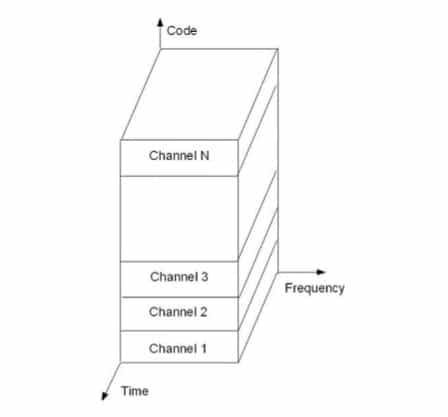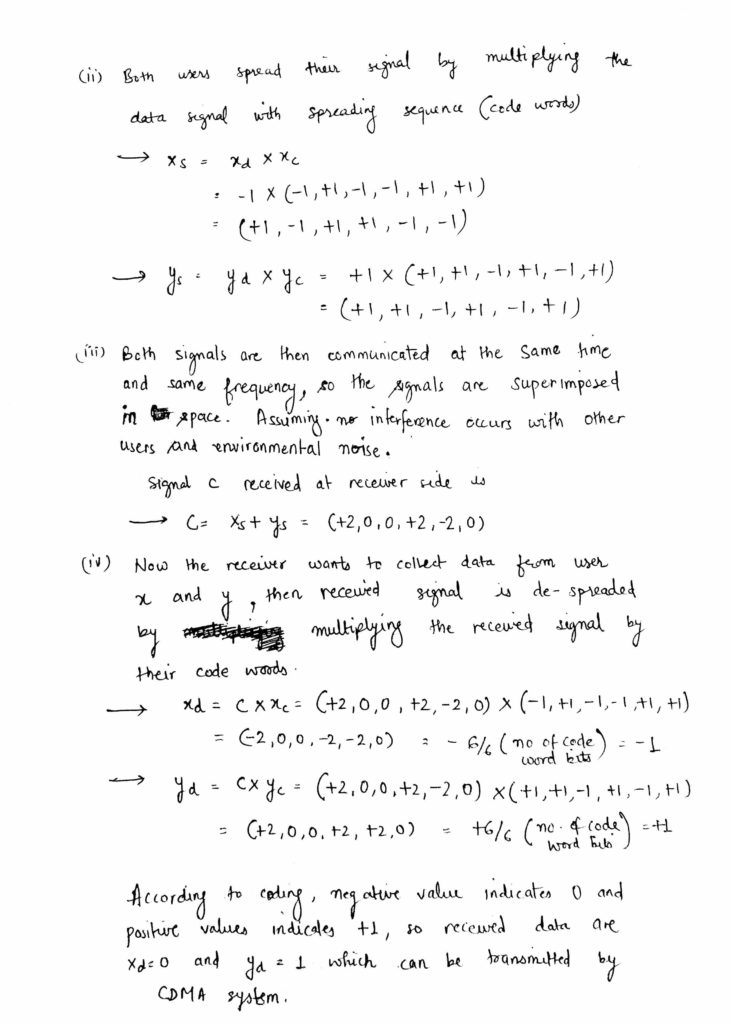1. CDMA (Code Division Multiple Access) is a direct-sequence spread spectrum (DSSS) based technique for multiplexing.
2. Principle:
– CDMA assigns a unique code sequence to each user which is used to code data before transmission.
– If a receiver knows the code sequence related to a user, it is able to decode the received data.
3. The codes are shared by the mobile phone and the base station. The codes are called Pseudo-random code sequences.
4. In CDMA systems, all the users can access the entire spectrum allocation all of the time as shown in the below figure.

5. All the users have a unique pseudo-random code (also known as chipping code) which separates them from other users. This code is used to increase the data rate of the transmission, resulting in an increased signal bandwidth. These chipping codes are orthogonal in nature which enables the receiver to recover the transmission of an individual unit from multiple transmissions.
6. CDMA systems can handle an unspecified number of users.
7. The capacity of the system depends on the quality of current calls. As more users are added, more noise is added, which in turn decreases the quality of the current call.
– When a new user is added, its transmission power increases the level of “noise floor” in frequency spectrum which decreases the overall call quality for all users.
– To eliminate “noise floor”, CDMA mobile phones and BS use the min. amount of power required to communicate with each other.
8. In CDMA systems, the data signal is multiplied by the spreading sequence. We can understand the CDMA working with the following example:


Advantages:
1. Improves call quality by filtering out background noise, crosstalk and interference.
2. Soft Handoff: It provides soft handoff in mobile comm. as handoffs, between cells are undetected by the user.
3. Precise Power Control: It increases talk-time and battery life for mobile phones.
4. High capacity: Since each user has a unique code and it uses total radio spectrum, the capacity of the system is very high.
5. Privacy: Since spread spectrum is obtained by the use of noise-like signals where each user has a unique code, privacy is inherent.
6. Simplified frequency planning: Since all users on CDMA uses the same radio frequency spectrum, it simplifies the frequency planning.
7. CDMA gives high data rate and low multi-path fading due to low autocorrelation and low cross-correlation properties of code words.
Disadvantages:
1. Backward compatibility techniques are costly.
2. Difficult to optimise to maximise performance.
3. Low traffic areas lead to inefficient use of spectrum and equipment resources.
4. Self Jamming occurs in CDMA system because code words of all users are not perfectly orthogonal as a result of which they produce large interference.
5. Near Far problem: According to this, signals near to the receiver are received with less attenuation (high power) than signals far away and create the interference to other users.
6. Soft Handoff: It is more complex than hard handoff used in FDMA and TDMA.
Applications of CDMA:
1. It is used for wireless systems with a fixed base station and many mobile stations at a varying distance from it.
2. Used in satellite systems so that many signals can use a transponder, making it more efficient.
3. Used in digital cellular telephone services because it permits more users to occupy a given band.
4. Wideband CDMA (W-CDMA) is used for digital cell phone systems to accommodate voice transmission along with high-speed data, FAX and internet communication.
5. CDMA is also used in the military because of immunity to noise.
Limitations of CDMA:
1. CDMA system requires power control to achieve high capacity.
2. Receivers used for CDMA reception are much complex than those used in TDMA or FDMA systems.
3. CDMA systems operate at high chip rate and require PN synchronization at the receiver.
4. With the increase in processing gain, the maximum transmission rate in each code channel is limited. This can be overcome by parallel transmission of information to or from the mobile user.
